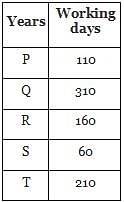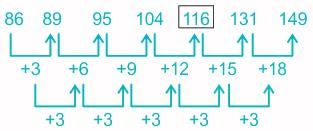KTET Paper 1: Mathematics Test - 2 - KTET MCQ
30 Questions MCQ Test KTET Mock Test Series 2024 - KTET Paper 1: Mathematics Test - 2
Directions: Answer the following question by selecting the most appropriate option.
A tank contains 240 litres(L) and 128 millilitres(mL) of milk, which can be filled completely in 16 same-sized jars. How much milk will be there in 22 such jars?
A tank contains 240 litres(L) and 128 millilitres(mL) of milk, which can be filled completely in 16 same-sized jars. How much milk will be there in 22 such jars?
The simple interest on a sum of money ₹800 for 2 years at 5% p.a. is:
| 1 Crore+ students have signed up on EduRev. Have you? Download the App |
A clock is set right at 10 p.m. It gains 12 minutes in 1 day. What it will be the correct time when it indicates 1 a.m.?
Mathematics involves the study of numbers, quantities, different patterns, sequences, etc. What is the nature of mathematics?
The NCF (2005) considers that Mathematics involves 'a certain way of thinking and reasoning. The vision can be realized by_____.
Identify the incorrect statement with regard to teaching the concept of geometry at primary level.
If you aspire to become a successful mathematics teacher, then how would you establish and check the interpersonal activities of your students?
In the figure, side of each square is 1 cm. The area, in square cm, of the shaded part is _____.
A car travels from A to B and then to C. The car takes 3 hours to travel from A to B at an average speed of 42 km/hr. It travels 128 km from B to C at an average speed of 64 km/hr. If the car takes a total of 5 hours, what is the average speed of the car travelling from A to C?
(The smallest common multiple of 16, 20, and 36) ÷ (the largest common factor of 16, 20 and 36) is equal to:
If an operator ⊕ is defined as
- 4⊕3=4+5+6
- 5⊕4=5+6+7+8
- 6⊕4=6+7+8+9
What will n⊕8 be equal to ?
If the cost of 5 apples and 3 oranges is Rs. 210 and the cost of 4 apples and 2 oranges is Rs. 160, then how many apples can we buy with Rs. 120?
The difference between the place value and the face value of 5 in 35362 is:
The length, breadth and height of a cuboidal box is 25 cm, 7.5 m and 85 cm. Find the volume of the box.
Rubrics of assessment for the geometry lesson on points and lines in Class IV
Which of the following statement does not contains nominal numbers?
The sum of place value of 6 in 63606 is _____.
The table given below shows the number of working days of a company in 5 years.

What are ratio of number of working days in year R to the number of working days in year T?
Akram was asked by his teacher about how he would get the area of a rectangle. Akram replied that the multiplication of length and breadth will give the area of a rectangle. Therefore, the questions that start by using the word "how" are
Students are asked to establish a relation between vertically opposite angles. They draw various figures, measure the angles and observe that vertically opposite angles are equal. In this case, students according to Van hie le thoughts are at _____.
Select the number from among the given options that can replace the question mark (?) in the following series.
86, 89, 95, 104, ?, 131, 149
Most appropriate formative task to assess the students' understanding of data analysis is
To introduce the concept of area, a teacher can start with:
Which activity is not involved in teaching of mathematics in class room?
Perimeters of a rectangle and a square are equal. The perimeter of the square is 96 cm and breadth of the rectangle is 4 cm less than one side of the square. Then two times the area (in square cm) of the rectangle is:
Out of the following, which of the option below not shows the characteristics of pupils with creativity in Mathematics?
|
100 tests
|






















